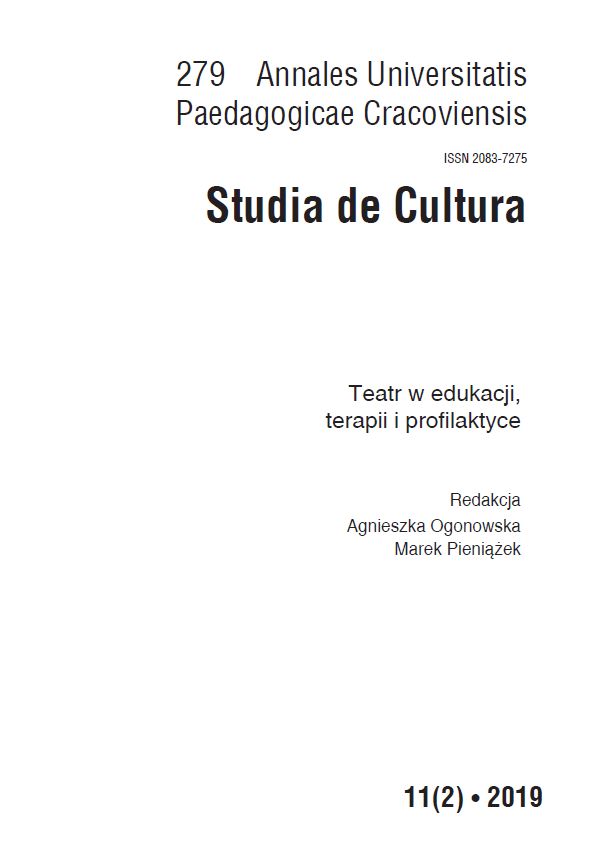Abstrakt
Artykuł stanowi refleksję na temat edukacyjnych walorów klasycznego tańca indyjskiego. Indyjski taniec klasyczny łączy dwa aspekty: taniec abstrakcyjny (sanskr. nritta) i taniec przedstawiający (sanskr. nritja). Szczególnie ta druga postać tańca - w której tancerz lub tan- cerka, za pomocą ruchów ciała, skodyfikowanego języka gestów oraz mimiki twarzy, prze- kazuje treści i opowiada historie - stanowić może nośnik treści edukacyjnych. Przyjmując za punkt wyjścia role, jakie przedstawieniu teatralnemu wyznacza najstarszy zachowany indyjski traktat o teatrze, Natjaśastra, artykuł przedstawia, jak edukacyjna rola tradycji ta- neczno-teatralnych realizowana jest współcześnie. Główny przedmiot analizy stanowi jeden z najbardziej znanych stylów indyjskiego tańca klasycznego - bharatanatjam.
Bibliografia
Review nr 3(41). 63-100.
Bajaj Tanvi, Vohra Swasti Shrimali. 2013. Performing Arts and Therapeutic Implications.
New Delhi.
Banerjee Neepa, Chatterjee Surjani, Kundu Sreejita., Bhattacharjee Satabdi, Mukherjee
Shankarashis. 2014. “Effect of Regular Practicing Bharatanatyam Dancing Exercise
on Body Fat of Urban Female Teenagers”. Indian Journal of Clinical Anatomy and
Physiology nr 1(1). 29-33.
Bhavnani Enakshi. 1984. The Dance in India: the origin and history, foundations, the art
and science of the dance in India. Bombay.
Bose Mandakranta. 1991. Movement and Mimesis. The Idea of Dance in the Sanskritic
Chatterjee Arpita. 2013. “The Therapeutic Value of Indian Classical, Folk and Innovative
Dance Forms”. Rupkatha Journal nr 1(5). 75-83.
Cieślikowski Sławomir, Hładij Hubert, Galewicz Cezary. (red.). 2016. Teoria literatury
w dawnych Indiach. Kraków.
Flood Gavin. 2008. Hinduizm. Wprowadzenie. M. Ruchel (przeł.). Kraków.
Ghosh Manomohan. (red.). 1951. The Nāyaśāstra. A Treatise on Hindu Dramaturgy and
Histrionics Ascribed to Bharata-Muni, t. I. Calcutta.
Ghosh Manomohan. (red.). 1961. The Nāyaśāstra. A Treatise on Hindu Dramaturgy and
Histrionics Ascribed to Bharata-Muni, t. II. Calcutta.
Ghosh Manomohan. (red.). 1975. Nandikeśvara’s „Abhinayadarpaam”. A Manual of Ges-
ture and Posture Used in Ancient Indian Dance and Drama. Calcutta (wyd. III).
Iyer Alessandra. 1993. “A Fresh Look at Ntta (Or Ntta: Steps in the Dark?)”. Dance Re-
search: The Journal of the Society for Dance Research nr 2(11). 3-15.
Katrak Ketu H. 2004. “Cultural Translation of Bharatanatyam into Contemporary Indian
Dance: Second generation South Asian Americans and cultural politics in diasporic
locations”. South Asian Popular Culture nr 2(2). 79-102.
Kothari Sunil. 2000. Bharata Natyam. Mumbai.
Kothari Sunil. 2002. “Dance education in India”. Prospectus nr 4(32). 483-489.
Leucci Tiziana. 2008. “L’apprentissage de la danse en Inde du Sud et ses transformations
au XXème siècle : le cas des devadāsī, rājadāsī et nat t uvan ār”. Rivista di Studi Suda-
siatici nr 3. 49-83.
Marlewicz Halina. 1998. O interpretacjach idei „rasa” w staroindyjskiej teorii dramatu.
Teatr Orientu. Materiały z sesji naukowej. P. Piekarski (red.). Kraków. 93-101.
Meduri Avanthi. 2004. “Bharatanatyam as a Global Dance: Some Issues in Research,
Teaching, and Practice”. Dance Research Journal nr 2(36). 11-29.
Meduri Avanthi. 2008. “Labels, Histories, Politics: Indian/South Asian Dance on the Glob-
al Stage”. Dance Research: The Journal of the Society for Dance Research nr 2(26).
223-243.
Mishra Suprava. 2001. “The Role of Indian Classical Dance in Education”. Narthaki.
http://www.narthaki.com/info/articles/article22.html [dostęp: 15.05.2019].
Mukherjee Shankarashis, Banerjee Neepa, Chatterjee Sandipan. 2012. “Effect of
Bharatanatyam Dancing on Body Composition and Physical Fitness Status of Adult
Bengalee Females”. Indian Journal of Biological Sciences nr 18. 9-15.
Mukherjee Shankarashis, Chatterjee Sandipan, Banerjee Neepa, Chatterjee Sandipan.
2014. “Effect of Practicing Select Indian Classical Dance Forms on Body Composi-
tion Status of Bengalee Females: an Anthropometric Study”. International Journal of
Business Strategy nr 20. 40-48.
Narayan Shovana. 2004. Indian Theatre and Dance Traditions. New Delhi.
O’Shea Janet. 2003. “At Home in the World?: The Bharatanatyam Dancer As Transnation-
al Interpreter”. The Drama Review nr 1(47). 176-186.
Ohtani Kimiko. 1991. “Bharata Nāṭyam, Rebirth of Dance in India”. Studia Musicologica
Academiae Scientiarum Hungaricae nr 1/4 (33). 301-308.
Pillai Shanti. 2002. “Rethinking Global Indian Dance through Local Eyes: The Contem-
porary Bharatanatyam Scene in Chennai”. Dance Research Journal nr 2(34). 14-19.
Prickett Stacey. 2004. “Techniques and Institutions: The Transformation of British Dance
Tradition through South Asian Dance”. Dance Research: The Journal of the Society
for Dance Research nr 1(22). 1-21.
Prickett Stacey. 2007. “Guru or Teacher? Shishya or Student? Pedagogic Shifts in South
Asian Dance Training in India and Britain”. South Asia Research nr 1(27). 25-41.
Putinja Isabel. 2011. The last disciple: An interview with Dominique Delorme. http://
www.sacredspaceblog.com/2011/03/last-disciple-interview-with-dominique.
html [dostęp: 15.05.2019].
Saigal Ranjani. 2013. “In Conversation With Geeta Chandran”. Lokvani. http://www.lo-
kvani.com/lokvani/article.php?article_id=4215 [dostęp: 15.05.2019].
Satkunaratnam Ahalya. 2013. “Staging War. Performing Bharata Natyam in Colombo, Sri
Lanka”. Dance Research Journal 45(1). 81-108.
Vatsyavan Kapila. 1977. Classical Indian Dance in Literature and the Arts. New Delhi.
Vatsyayan Kapila. 1992. Indian Classical Dance. New Delhi.
Warren Vincent. 2006. “Yearning for the Spiritual Ideal: The Influence of India on Western Dance 1626-2003". Dance Research Journal. nr1/2(38). 97-114.

